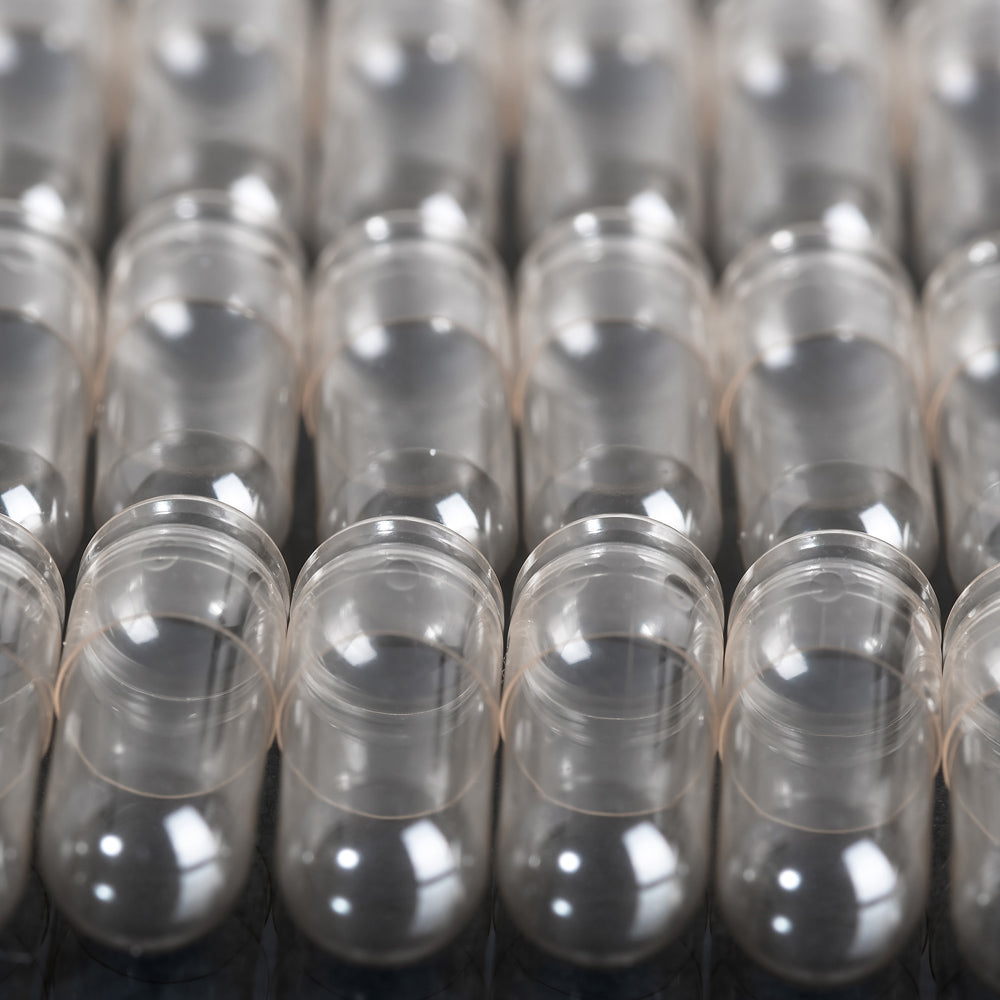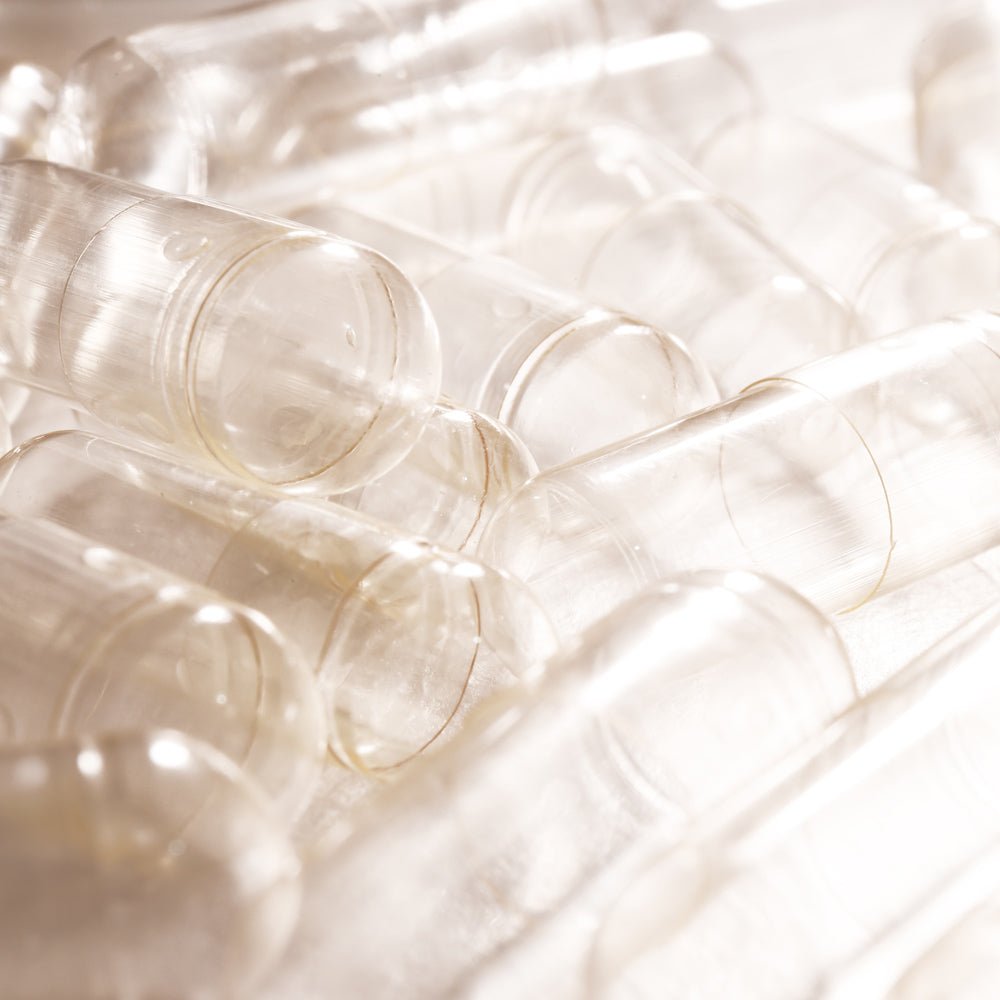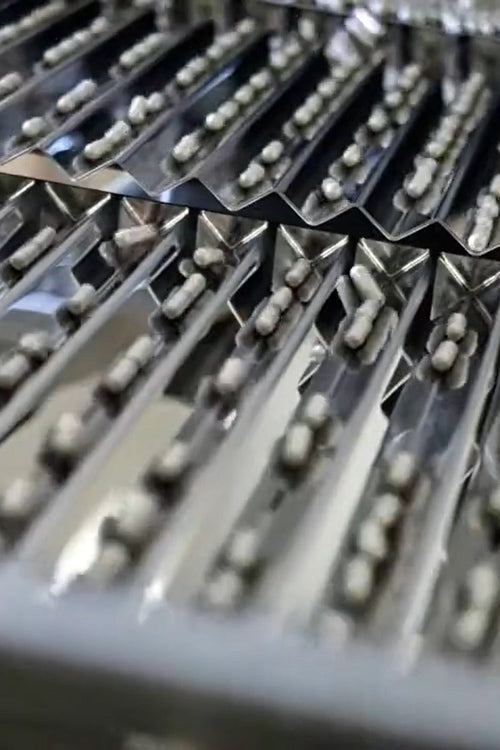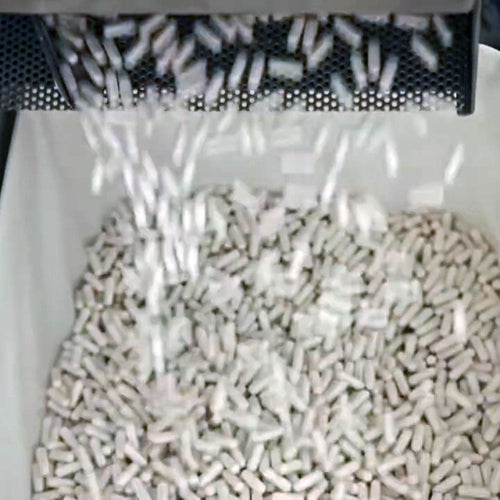
Capsules Redefined
When buying supplements, most people never consider the delivery format - whether capsules, tablets, gummies, or even the materials they're made from. Yet this oversight could be crucial, as the delivery system is potentially the most important factor in determining your supplement's effectiveness, second only to the ingredients themselves.
Tablets are a more economical choice for manufacturers, as they are cheaper and quicker to produce. Gummies are also very popular due to their pleasant taste and ease of consumption.
However at Puramins our commitment to purity and effectiveness led us to choose capsules containing pure powder for a number of reasons.
Benefits of Capsules
Manufacturing Process
Tablets and gummies require multiple binding agents, fillers, and other excipients to hold them together and control their dissolution rate. This often results in a long list of additional ingredients - sometimes up to twenty different compounds - that have no nutritional value. These binding agents and excipients can potentially cause digestive discomfort, particularly in sensitive individuals (1,2).
Absorption
Tablets and gummies need to break down completely before their nutrients can be absorbed, which can be challenging for many people. Poor tablet disintegration can significantly reduce the bioavailability of active ingredients, meaning you might not get the full benefit of your supplement. Capsules, by contrast, dissolve readily in the digestive system, allowing for optimal absorption of nutrients.
Purity
With capsules, we can focus solely on delivering pure, active ingredients without the need for multiple binding agents, artificial colourants, or flavourings. This aligns perfectly with our commitment to clean, additive-free supplementation.
Flexibility
Capsules also offer greater flexibility - they can be opened and mixed with food or drinks if needed, or a precise dose given, something that isn't possible with compressed tablets.
Stability
Capsules provide superior protection for sensitive ingredients like vitamin C, shielding them from light, air, and moisture. This results in better stability and a longer shelf life compared to tablets or gummies, ensuring the potency of the supplement over time (3).
Dosage Accuracy
Capsules allow for precise and consistent dosing of vitamin C. Unlike gummies, which may have varying amounts of active ingredients due to manufacturing processes, capsules can deliver an exact amount of vitamin C in each dose, ensuring you get the intended nutritional benefit every time (4).
The Choice of Capsule Material
For decades, the supplement industry relied heavily on animal-derived gelatin capsules, which dominated the market since their invention in the 19th century. As consumer awareness grew about both environmental and dietary concerns, manufacturers began exploring plant-based alternatives.
HPMC
The first major breakthrough came with HPMC capsules. Hydroxypropyl methylcellulose, also known as hypromellose or vegetable cellulose, is a semi-synthetic polymer derived from cellulose, the natural fibre found in plant cell walls. The material has become widely adopted in the supplement industry, particularly for its plant-based origins that make it suitable for vegetarians and those with specific dietary or religious requirements.
However the manufacturing process of HPMC involves significant chemical modification of natural cellulose. The production method requires treating cellulose with methyl chloride and propylene oxide through a process called alkali immersion (5). This chemical synthesis has raised environmental concerns, particularly regarding the emission of hazardous air pollutants, as highlighted by the US Environmental Protection Agency (6). Due to these manufacturing processes and its semi-synthetic nature, HPMC is not permitted in organic products, as ruled by the US National Organic Standards Board (NOSB) (7).
While HPMC capsules offer several advantages, including high moisture resistance that helps preserve the potency of their contents, they also have some limitations. For example the material is highly permeable to oxygen, which can potentially compromise the stability of ingredients contained within the capsules (8,9). From a safety perspective, HPMC is considered a non-fermentable fibre and has established safety parameters, with an official 'no-observed-adverse-effect level' (NOAEL) of 5000 mg/kg body weight/day, based on a 90-day rat feeding study (10). However, the 'tolerable intake upper limit' (UL) is set much lower at 5 mg/kg body weight/day (10), which translates to approximately three and a half average-sized HPMC capsules for a person weighing 154 pounds.

The new age of pullulan
Today, we stand at the cusp of a new era in supplement delivery technology. The evolution from traditional gelatin to HPMC to modern pullulan capsules represents more than just a change in materials – it's a fundamental shift in how we think about protecting and delivering vital nutrients. This advancement addresses not only the growing demand for plant-based options but also the critical need for superior ingredient preservation, something that previous technologies simply couldn't achieve.
This unique substance, first discovered in 1938, is produced through the fermentation of tapioca or other starches by the microorganism Aureobasidium pullulans (11, 12). Unlike many other capsule materials that rely on chemical processing, pullulan is created through an entirely natural fermentation process (11), resulting in a pure, flexible material that's perfect for supplement encapsulation.
Benefits of Pullulan Capsules
Superior oxygen protection
The molecular structure of pullulan provides exceptional oxygen-barrier properties. Being up to 300 times more effective than standard HPMC capsules, pullulan ensures maximum potency and freshness of the ingredients inside (8,9).
Natural origin
Suitable for all dietary preferences and ethical beliefs. Derived from fermented starch through a natural process, these capsules are vegan-friendly and free from common allergens.
Safe and hypoallergenic
Non-toxic, non-immunogenic, non-carcinogenic and non-mutagenic, pullulan is considered extremely safe for use (13, 14).
Environmentally friendly
Produced through an eco-conscious fermentation process that requires minimal energy consumption, the production of pullulan creates significantly less environmental impact compared to traditional HPMC capsules (11).
May act as a prebiotic
Research suggests pullulan has prebiotic properties that support beneficial gut bacteria, potentially offering additional health benefits beyond its role as a capsule material (15).
Organic certification
Unlike HPMC capsules, pullulan is certified for use in organic products by the US National Organic Standards Board, making it the ideal choice for premium organic supplements (7).


Why isn't pullulan more widely used?
You might be wondering why pullulan isn't used by more companies if it has so many advantages over HPMC. One of the key reasons is cost - pullulan capsules are significantly more expensive than standard HPMC alternatives.
Despite these higher costs, we remain unwavering in our commitment to quality. At Puramins, we will only ever use pullulan capsules for our products, ensuring you consistently receive the highest level of ingredient protection and potency.
Every capsule tells our story – one of relentless pursuit of perfection.
1) Balbani AP, Stelzer LB, Montovani JC. Pharmaceutical excipients and the information on drug labels. Braz J Otorhinolaryngol. 2006 May-Jun;72(3):400-6. (https://pubmed.ncbi.nlm.nih.gov/17119779/)
2) Pifferi G, Santoro P, Pedrani M. Quality and functionality of excipients. 1999. (https://www.sciencedirect.com/science/article/abs/pii/S0014827X98001013)
3) Susa F, Pisano R. Advances in Ascorbic Acid (Vitamin C) Manufacturing: Green Extraction Techniques from Natural Sources. Processes. 2023; 11(11):3167. (https://www.mdpi.com/2227-9717/11/11/3167)
4) Setiyaningsih1 N, Sumiati, Jayanegara A, Wardani W. Effects of a Vitamins D and C Supplement on
Performance, Hatchability, and Blood Profiles of Broiler Breeders. 2023. J. World Poult. Res. 13(1):71-80. (https://jwpr.science-line.com/attachments/article/71/JWPR%2013(1),%2071-80,%202023.pdf)
5) Hydroxypropylmethylcellulose. Science Direct. (https://www.sciencedirect.com/topics/nursing-and-health-professions/hydroxypropylmethylcellulose)
6) United States Environmental Protection Agency. Cellulose Products Manufacturing: National Emission Standards for Hazardous Air Pollutants (NESHAP). (https://www.epa.gov/stationary-sources-air-pollution/cellulose-products-manufacturing-national-emission-standards)
7) US Department of Agriculture. Hydroxypropyl Methylcellulose. (https://www.ams.usda.gov/sites/default/files/media/Hydroxpropyl%20Methylcellulose%20TR.pdf)
8) Yang N, Chen H, Jin Z, Hou J, Zhang Y, Han H, Shen Y, Guo S. Moisture sorption and desorption properties of gelatin, HPMC and pullulan hard capsules, International Journal of Biological Macromolecules, Volume 159, Pages 659-666. 2020. (https://www.sciencedirect.com/science/article/abs/pii/S0141813020332621)
9) Across Biotech. HPMC vs Pullulan: Which Is Better For Capsules? (https://acrossbiotech.com/hpmc-vs-pullulan-which-is-better-for-capsules/)
10) Burdock G. Safety assessment of hydroxypropyl methylcellulose as a food ingredient. Food and Chemical Toxicology, Volume 45, Issue 12, Pages 2341-2351. 2007. (https://www.sciencedirect.com/science/article/abs/pii/S027869150700261X)
11) Ghosh T, Priyadarshi R, Krebs de Souza C, Angioletti B, Rhim JW. Advances in pullulan utilization for sustainable applications in food packaging and preservation: A mini review. Trends in Food Science & Technology, Volume 125, Pages 43-53. 2022. (https://www.sciencedirect.com/science/article/abs/pii/S0924224422001613)
12) Kumar D, Saini N, Pandit V, Ali S. An Insight To Pullulan: A Biopolymer in Pharmaceutical Approaches. International Journal of Basic and Applied Sciences 1(3) June. 2012. (https://www.researchgate.net/publication/260320595_An_Insight_To_Pullulan_A_Biopolymer_in_Pharmaceutical_Approaches)
13) Prajapati VD, Jani GK, Khanda SM. Pullulan: an exopolysaccharide and its various applications. Carbohydr Polym. 2013 Jun 5;95(1):540-9. Epub 2013 Mar 13. (https://pubmed.ncbi.nlm.nih.gov/23618305/)
14) Singh R, Kaur N, Singh D, Purewal SS, Kennedy JF. Pullulan in pharmaceutical and cosmeceutical formulations: A review, International Journal of Biological Macromolecules, Volume 231, 2023, 123353. (https://www.sciencedirect.com/science/article/abs/pii/S0141813023002398)
15) Zhantlessova S, Savitskaya I, Kistaubayeva A, Ignatova L, Talipova A, Pogrebnjak A, Digel I. Advanced "Green" Prebiotic Composite of Bacterial Cellulose/Pullulan Based on Synthetic Biology-Powered Microbial Coculture Strategy. Polymers (Basel). 2022 Aug 8;14(15):3224. Erratum in: Polymers (Basel). 2024 Jun
26;16(13):1802. (https://pubmed.ncbi.nlm.nih.gov/35956737/)